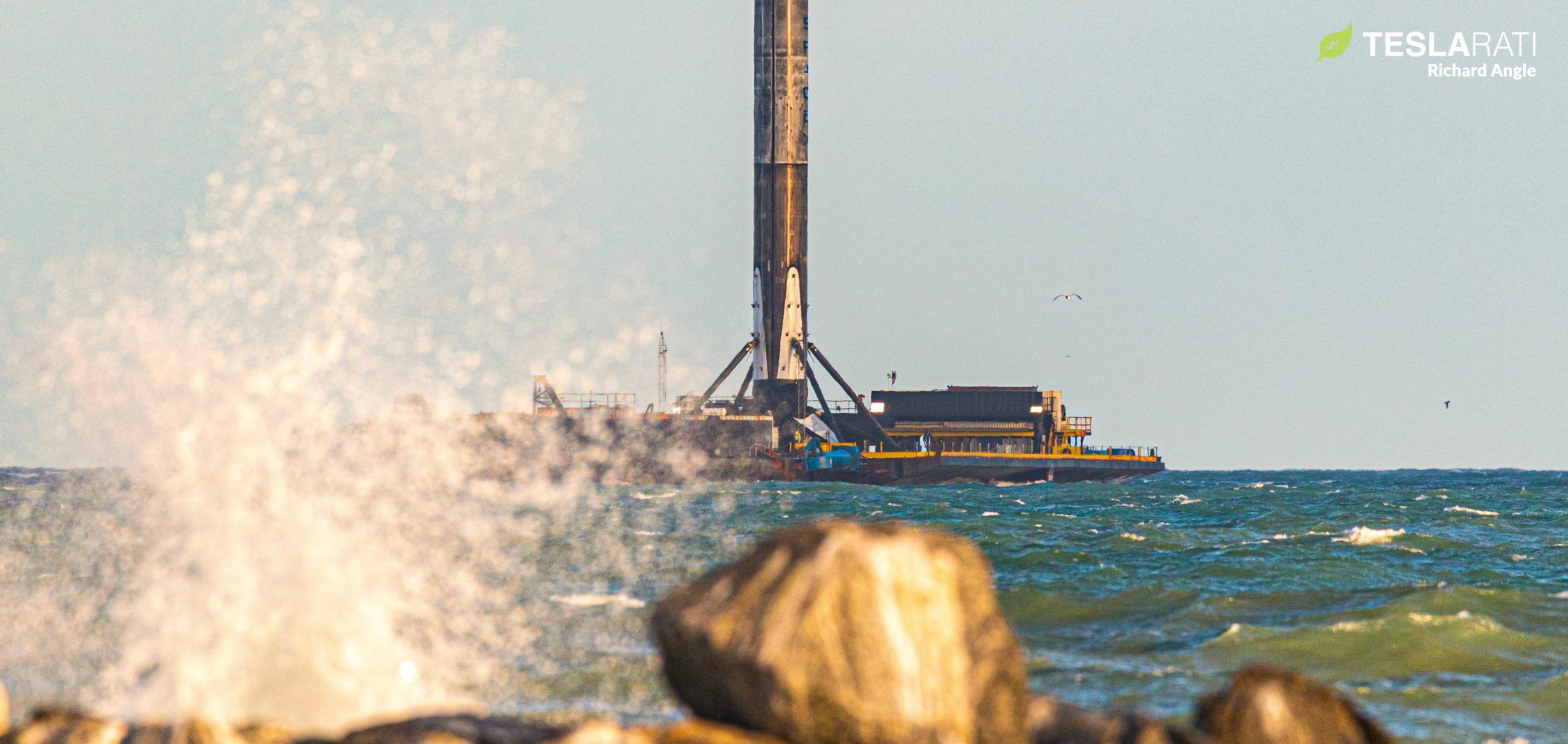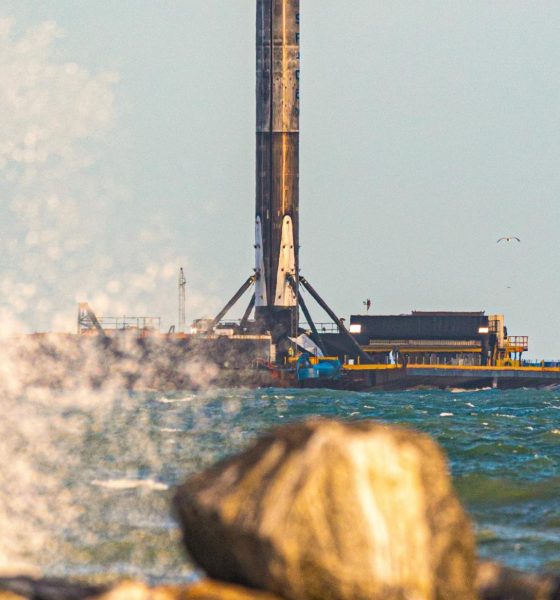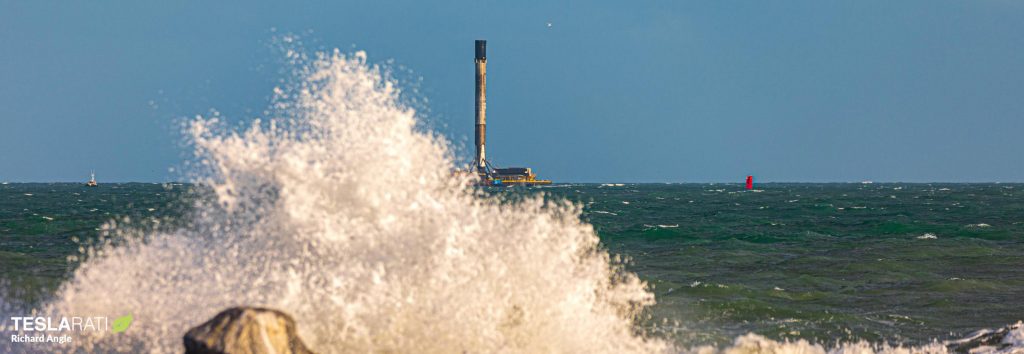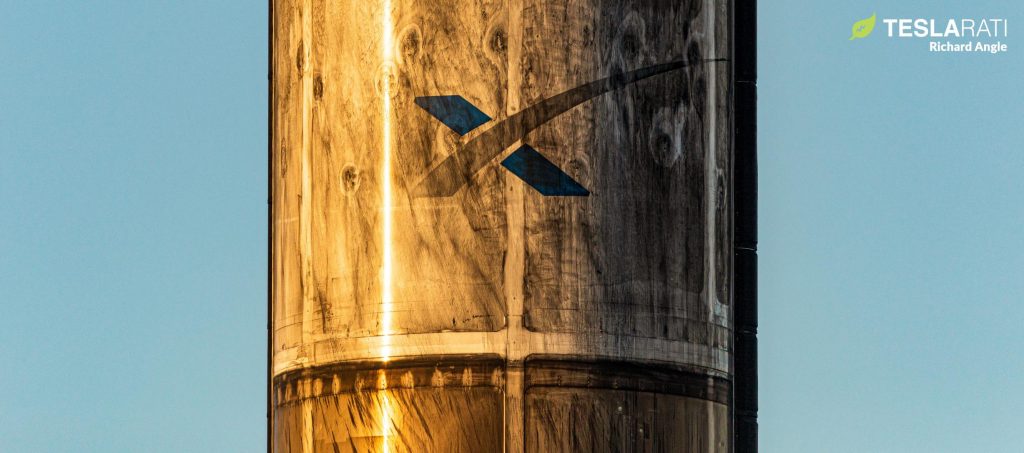

News
SpaceX Falcon 9 greeted by iconic Florida sunset after first rocket landing of the decade
After completing its fourth flawless orbital-class launch and landing in 16 months, SpaceX’s latest reusable Falcon 9 rocket has successfully returned to dry land and was greeted by a spectacular Florida sunset during its port arrival.
Safely secured aboard drone ship Of Course I Still Love You (OCISLY) by SpaceX’s famous Octagrabber robot, which uses claws its tank-like heft to physically hold the rocket down, Falcon 9 booster B1049 passed through the mouth of Port Canaveral on January 9th. This effectively marked the end of its third drone ship recovery and fourth landing overall since its orbital-class launch debut in September 2018, averaging a SpaceX launch every four months.
B1049.4 supported SpaceX’s second launch of upgraded Starlink v1.0 communications satellites and the 60 spacecraft it helped send to orbit almost certainly catapulted the company into the position of owning the world’s largest private satellite constellation – now measuring some 175 operational spacecraft strong. Those 60 new Starlink satellites have since deployed their solar arrays, performed basic systems checkouts, activated their krypton-fueled ion thrusters, and begun raising their orbits to around 350 km (220 mi). After arriving at 350 km, SpaceX will carefully analyze the performance of each satellite and send all healthy spacecraft to their final operational altitude of 550 km (340 mi).
Teslarati photographer Richard Angle was present for both sides of Falcon 9 B1049’s fourth orbital-class launch and landing, capturing the booster’s January 6th liftoff from Cape Canaveral Air Force Station Launch Complex 40 (CCAFS LC-40) and its January 9th Port Canaveral arrival aboard drone ship OCISLY. Given the spectacular Florida sunset that greeted the rocket, B1049 clearly has a preferred color palette – fire.



Falcon 9 B1049 is powered by nine Merlin 1D engines capable of burning liquid oxygen and refined kerosene (RP-1) to produce a maximum thrust of 7600 kN (1.7 million lbf), giving it a thrust to weight ratio of more than 1.4 even when fully loaded with some 525 metric tons (1.2 million lb) of propellant.
According to SpaceX and CEO Elon Musk, Falcon 9’s newest Block 5 boosters – debuted in May 2018 and expected to be the last major upgrade to the family – are designed to be capable of at least 10 orbital-class launches each. A step further, they could potentially be able to perform dozens of missions before retirement is unavoidable, although that would reportedly require the same sort of in-depth overhauls that are routine for modern airliners. Regardless of SpaceX’s aspirations of 10-100 flights per booster, the company is making great progress but undeniably has a long ways to go.



Still, it’s not actually as long as it may seem. On January 6th, Falcon 9 B1049 became the second SpaceX booster to successfully launch four times, following in the footsteps of B1048’s record-breaking fourth flight – completed in November 2019. Now in possession of two consecutively-built Falcon 9 boosters with four flights under each of their belts, SpaceX should be able to quickly determine whether its fleet of reusable rockets can be trusted with four launches (and more).
Additionally, after two months for technicians and engineers to inspect and repair the booster, B1048 could be ready for its fifth launch far sooner than later. SpaceX wrapped up B1049’s fourth post-recovery processing on January 13th – a relatively brisk three and a half days from port arrival to horizontal transport. The booster was moved to one of SpaceX’s many Cape Canaveral hangars, where – just like B1048 – it will be inspected, refurbished, and turned around for its fifth launch sometime in the near future.
Check out Teslarati’s Marketplace! We offer Tesla accessories, including for the Tesla Cybertruck and Tesla Model 3.

News
Tesla starts showing how FSD will change lives in Europe
Local officials tested the system on narrow country roads and were impressed by FSD’s smooth, human-like driving, with some calling the service a game-changer for everyday life in areas that are far from urban centers.

Tesla has launched Europe’s first public shuttle service using Full Self-Driving (Supervised) in the rural Eifelkreis Bitburg-Prüm region of Germany, demonstrating how the technology can restore independence and mobility for people who struggle with limited transport options.
Local officials tested the system on narrow country roads and were impressed by FSD’s smooth, human-like driving, with some calling the service a game-changer for everyday life in areas that are far from urban centers.
Officials see real impact on rural residents
Arzfeld Mayor Johannes Kuhl and District Administrator Andreas Kruppert personally tested the Tesla shuttle service. This allowed them to see just how well FSD navigated winding lanes and rural roads confidently. Kruppert said, “Autonomous driving sounds like science fiction to many, but we simply see here that it works totally well in rural regions too.” Kuhl, for his part, also noted that FSD “feels like a very experienced driver.”
The pilot complements the area’s “Citizen Bus” program, which provides on-demand rides for elderly residents who can no longer drive themselves. Tesla Europe shared a video of a demonstration of the service, highlighting how FSD gives people their freedom back, even in places where public transport is not as prevalent.
What the Ministry for Economic Affairs and Transport says
Rhineland-Palatinate’s Minister Daniela Schmitt supported the project, praising the collaboration that made this “first of its kind in Europe” possible. As per the ministry, the rural rollout for the service shows FSD’s potential beyond major cities, and it delivers tangible benefits like grocery runs, doctor visits, and social connections for isolated residents.
“Reliable and flexible mobility is especially vital in rural areas. With the launch of a shuttle service using self-driving vehicles (FSD supervised) by Tesla in the Eifelkreis Bitburg-Prüm, an innovative pilot project is now getting underway that complements local community bus services. It is the first project of its kind in Europe.
“The result is a real gain for rural mobility: greater accessibility, more flexibility and tangible benefits for everyday life. A strong signal for innovation, cooperation and future-oriented mobility beyond urban centers,” the ministry wrote in a LinkedIn post.
News
Tesla China quietly posts Robotaxi-related job listing
Tesla China is currently seeking a Low Voltage Electrical Engineer to work on circuit board design for the company’s autonomous vehicles.

Tesla has posted a new job listing in Shanghai explicitly tied to its Robotaxi program, fueling speculation that the company is preparing to launch its dedicated autonomous ride-hailing service in China.
As noted in the listing, Tesla China is currently seeking a Low Voltage Electrical Engineer to work on circuit board design for the company’s autonomous vehicles.
Robotaxi-specific role
The listing, which was shared on social media platform X by industry watcher @tslaming, suggested that Tesla China is looking to fill the role urgently. The job listing itself specifically mentions that the person hired for the role will be working on the Low Voltage Hardware team, which would design the circuit boards that would serve as the nervous system of the Robotaxi.
Key tasks for the role, as indicated in the job listing, include collaboration with PCB layout, firmware, mechanical, program management, and validation teams, among other responsibilities. The role is based in Shanghai.
China Robotaxi launch
China represents a massive potential market for robotaxis, with its dense urban centers and supportive policies in select cities. Tesla has limited permission to roll out FSD in the country, though despite this, its vehicles have been hailed as among the best in the market when it comes to autonomous features. So far, at least, it appears that China supports Tesla’s FSD and Robotaxi rollout.
This was hinted at in November, when Tesla brought the Cybercab to the 8th China International Import Expo (CIIE) in Shanghai, marking the first time that the autonomous two-seater was brought to the Asia-Pacific region. The vehicle, despite not having a release date in China, received a significant amount of interest among the event’s attendees.
Elon Musk
Elon Musk and Tesla AI Director share insights after empty driver seat Robotaxi rides
The executives’ unoccupied tests hint at the rapid progress of Tesla’s unsupervised Robotaxi efforts.

Tesla CEO Elon Musk and AI Director Ashok Elluswamy celebrated Christmas Eve by sharing personal experiences with Robotaxi vehicles that had no safety monitor or occupant in the driver’s seat. Musk described the system’s “perfect driving” around Austin, while Elluswamy posted video from the back seat, calling it “an amazing experience.”
The executives’ unoccupied tests hint at the rapid progress of Tesla’s unsupervised Robotaxi efforts.
Elon and Ashok’s firsthand Robotaxi insights
Prior to Musk and the Tesla AI Director’s posts, sightings of unmanned Teslas navigating public roads were widely shared on social media. One such vehicle was spotted in Austin, Texas, which Elon Musk acknowleged by stating that “Testing is underway with no occupants in the car.”
Based on his Christmas Eve post, Musk seemed to have tested an unmanned Tesla himself. “A Tesla with no safety monitor in the car and me sitting in the passenger seat took me all around Austin on Sunday with perfect driving,” Musk wrote in his post.
Elluswamy responded with a 2-minute video showing himself in the rear of an unmanned Tesla. The video featured the vehicle’s empty front seats, as well as its smooth handling through real-world traffic. He captioned his video with the words, “It’s an amazing experience!”
Towards Unsupervised operations
During an xAI Hackathon earlier this month, Elon Musk mentioned that Tesla owed be removing Safety Monitors from its Robotaxis in Austin in just three weeks. “Unsupervised is pretty much solved at this point. So there will be Tesla Robotaxis operating in Austin with no one in them. Not even anyone in the passenger seat in about three weeks,” he said. Musk echoed similar estimates at the 2025 Annual Shareholder Meeting and the Q3 2025 earnings call.
Considering the insights that were posted Musk and Elluswamy, it does appear that Tesla is working hard towards operating its Robotaxis with no safety monitors. This is quite impressive considering that the service was launched just earlier this year.








